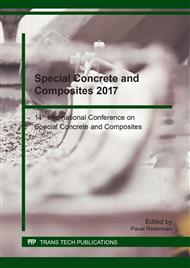[1]
O. Holčapek, Resistance of refractory cement composite to cyclic temperature loading, Key Engineering Materials 677 (2016) 23–28.
DOI: 10.4028/www.scientific.net/kem.677.23
Google Scholar
[2]
T. Pavlů, M. Šefflová, Study of the Freeze-Thaw resistance of the fine-aggregate concrete, presented at the EAN 2016 - 54th International Conference on Experimental Stress Analysis, (2016).
Google Scholar
[3]
CSN EN 206-1 Concrete: Specification, performance, production and conformity, (in czech), Prague. CEN, (2014).
Google Scholar
[4]
L. Evangelista, M. Guedes, J. de Brito, A. C. Ferro, and M. F. Pereira, Physical, chemical and mineralogical properties of fine recycled aggregates made from concrete waste, Constr. Build. Mater., vol. 86, p.178–188, Jul. (2015).
DOI: 10.1016/j.conbuildmat.2015.03.112
Google Scholar
[5]
D. Pedro, J. de Brito, and L. Evangelista, Structural concrete with simultaneous incorporation of fine and coarse recycled concrete aggregates: Mechanical, durability and long-term properties, Constr. Build. Mater., vol. 154, p.294–309, Nov. (2017).
DOI: 10.1016/j.conbuildmat.2017.07.215
Google Scholar
[6]
A. K. H. Kwan, P. L. Ng, and K. Y. Huen, Effects of fines content on packing density of fine aggregate in concrete, Constr. Build. Mater., vol. 61, p.270–277, Jun. (2014).
DOI: 10.1016/j.conbuildmat.2014.03.022
Google Scholar
[7]
M. Šefflová, T. Pavlů, Non-Destructive Testing of Concrete with Fine Recycled Aggregate, Applied Mechanics and Materials 825, (2016) 63–68.
DOI: 10.4028/www.scientific.net/amm.825.63
Google Scholar
[8]
T. Pavlů and M. Šefflová, Experimental determination and estimation of water absorption capacity of hardened concrete with recycled aggregate, presented at the EAN 2014 - 52nd International Conference on Experimental Stress Analysis, (2014).
DOI: 10.4028/www.scientific.net/amm.732.411
Google Scholar
[9]
EN 196-1 Methods of testing cement. Determination of strength'. CEN, (2016).
Google Scholar
[10]
CSN 73 1322- Determination of frost resistance of concrete (in czech), Prague'. UNMZ, (1969).
Google Scholar
[11]
CSN EN 933-1 Tests for geometrical properties of aggregates - Part 1: Determination of particle size distribution - Sieving method, (in czech), Prague'. CEN, (2012).
DOI: 10.3403/01236185
Google Scholar
[12]
CSN EN 12620+A1 Aggregate for concrete'. CEN, (2008).
Google Scholar
[13]
CSN EN 1015-3: Methods of test for mortar for masonry - Part 3: Determination of consistence of fresh mortar (by flow table), (in czech), Prague'. CEN, (2000).
DOI: 10.3403/01541440
Google Scholar


